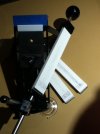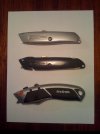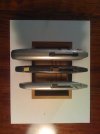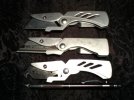Back on topic (as the OP pointed out):
Murray Carter is a pretty respected figure in the sharpening community, having sharpened something like 60,000 traditional Japanese blades, both during his long (13 year?) apprenticeship in Japan, and after in his own business making his own blades, at Carter Cutlery.
Carter has done several for-pay videos on the technique of sharpening. I own his latest ones and found them to be very interesting and informative; recommended. Carter shows that all finishing strokes on the fine stone should be done edge trailing. Of course he is using traditional Japanese waterstones; in his case rather soft King brand stones. I believe that the slurry made by the waterstone tends to inhibit burr formation. This counteracts the natural tendency for a trailing stroke to create a bigger burr than an edge leading stroke.
Other learned members here have repeatedly said that soft stones can be used edge trailing to finish, while hard stones should be used edge leading. In particular, diamond stones are always recommended to be used edge leading. Then again, our man David Martin, just a few posts above talked about his good success using a diamond stone edge trailing! So all rules can apparently be broken if your technique is good enough.

Our guy Heavy Handed designed, built, and sells the Washboard Sharpening System. This is designed to be used with sandpaper, regular paper with compound, diamond films, etc. As such, I guess it's closer to a soft stone than a hard one. Though certainly no slurry. HH seems to get very good results from his Washboard on just about any kind of blade using edge trailing strokes.
My personal experience with belt sanders is mixed. For a while I thought I was getting great edges from just the belts (all the way to 4 micron belts or sometimes higher) and indeed the edges passed most of my tests with ease. Waving through phonebook paper, easily shaving arm hair, etc. But lately I've taken to finishing all of my belt sander edges with the SharpMaker. Edge leading strokes on the SharpMaker. I was sort of shocked the first time I did this and watched a rather enormous amount of burr material slog off of the edge. This was on soft kitchen cutlery and I had taken off TONS of metal as these blades had not been sharpened in (literally) 20 years of continuous use. Perhaps if I had deburred at the end of each belt very carefully, I would not have been left with such a huge burr. The SharpMaker made short work of it however, and I ended up with what seemed like great edges. I will continue to use this method for a while until I figure out something else, or settle on this as my standard belt sander finishing method.
Brian.




